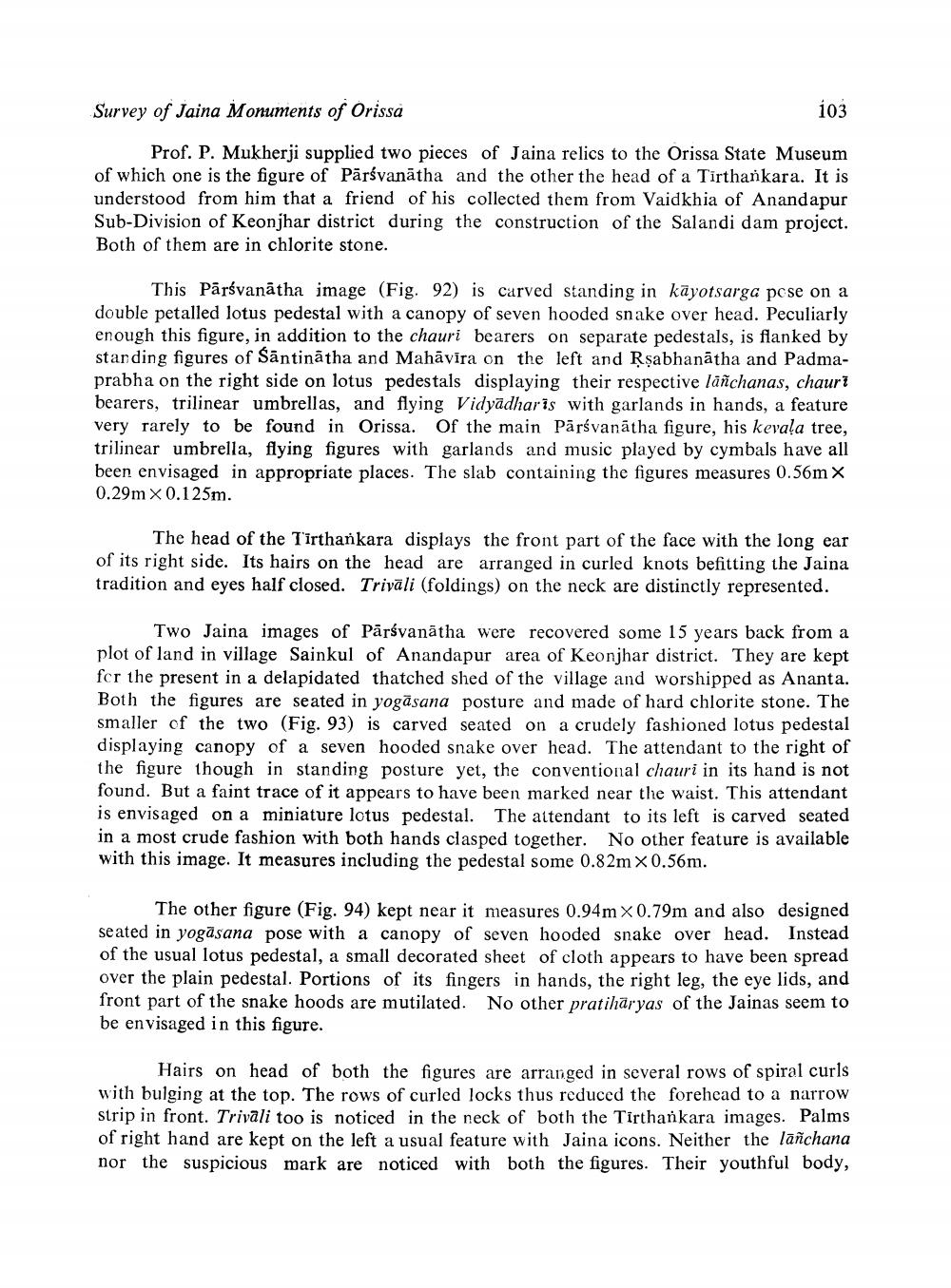________________
Survey of Jaina Monuments of Orissa
103
Prof. P. Mukherji supplied two pieces of Jaina relics to the Orissa State Museum of which one is the figure of Pārśvanatha and the other the head of a Tirthankara. It is understood from him that a friend of his collected them from Vaidkhia of Anandapur Sub-Division of Keonjhar district during the construction of the Salandi dam project. Both of them are in chlorite stone.
This Pärivanatha image (Fig. 92) is carved standing in kayotsarga pese on a double petalled lotus pedestal with a canopy of seven hooded snake over head. Peculiarly enough this figure, in addition to the chauri bearers on separate pedestals, is flanked by standing figures of Santinatha and Mahavira on the left and Rṣabhanatha and Padmaprabha on the right side on lotus pedestals displaying their respective lañchanas, chauri bearers, trilinear umbrellas, and flying Vidyadharts with garlands in hands, a feature very rarely to be found in Orissa. Of the main Parsvanatha figure, his kevala tree, trilinear umbrella, flying figures with garlands and music played by cymbals have all been envisaged in appropriate places. The slab containing the figures measures 0.56m X 0.29mx 0.125m.
The head of the Tirthankara displays the front part of the face with the long ear of its right side. Its hairs on the head are arranged in curled knots befitting the Jaina tradition and eyes half closed. Trivali (foldings) on the neck are distinctly represented.
Two Jaina images of Parsvanatha were recovered some 15 years back from a plot of land in village Sainkul of Anandapur area of Keonjhar district. They are kept for the present in a delapidated thatched shed of the village and worshipped as Ananta. Both the figures are seated in yogasana posture and made of hard chlorite stone. The smaller of the two (Fig. 93) is carved seated on a crudely fashioned lotus pedestal displaying canopy of a seven hooded snake over head. The attendant to the right of the figure though in standing posture yet, the conventional chauri in its hand is not found. But a faint trace of it appears to have been marked near the waist. This attendant is envisaged on a miniature lotus pedestal. The attendant to its left is carved seated in a most crude fashion with both hands clasped together. No other feature is available with this image. It measures including the pedestal some 0.82m x 0.56m.
The other figure (Fig. 94) kept near it measures 0.94m x 0.79m and also designed seated in yogasana pose with a canopy of seven hooded snake over head. Instead of the usual lotus pedestal, a small decorated sheet of cloth appears to have been spread over the plain pedestal. Portions of its fingers in hands, the right leg, the eye lids, and front part of the snake hoods are mutilated. No other pratiharyas of the Jainas seem to be envisaged in this figure.
Hairs on head of both the figures are arranged in several rows of spiral curls with bulging at the top. The rows of curled locks thus reduced the forehead to a narrow strip in front. Trivali too is noticed in the neck of both the Tirthankara images. Palms of right hand are kept on the left a usual feature with Jaina icons. Neither the lanchana nor the suspicious mark are noticed with both the figures. Their youthful body,




